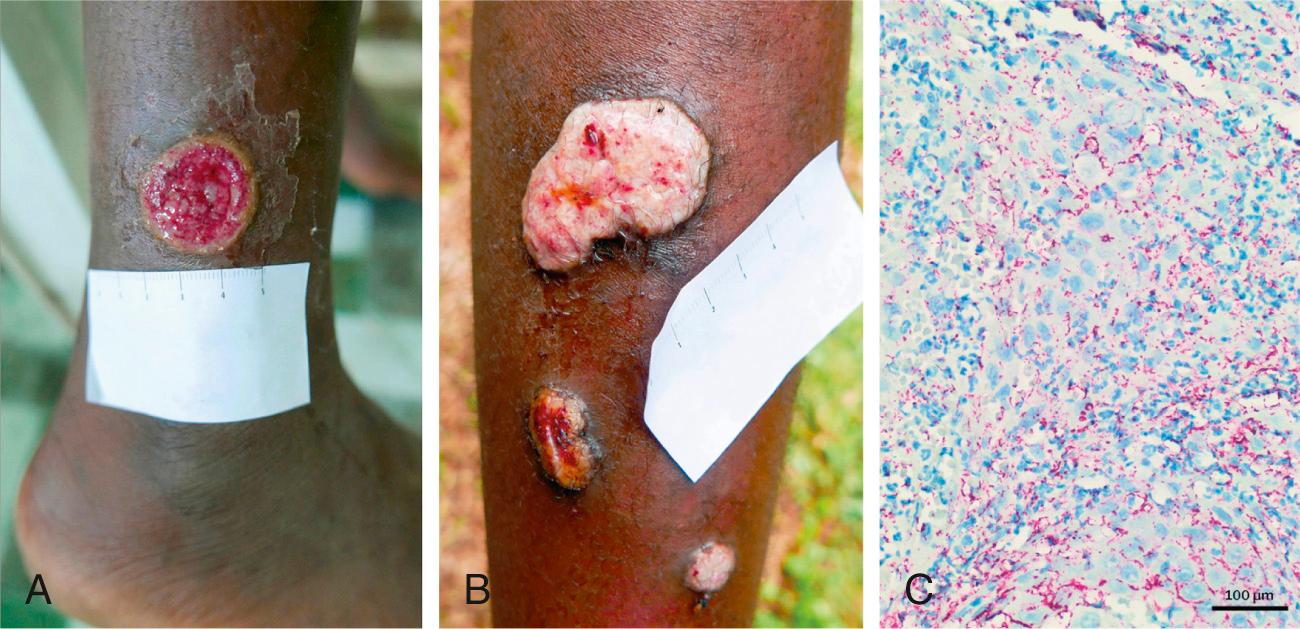Physical Address
304 North Cardinal St.
Dorchester Center, MA 02124
Nonvenereal treponemal infections—yaws, bejel (endemic syphilis), and pinta—are caused by different subspecies of Treponema pallidum and occur in tropical and subtropical areas. The causative agents of nonvenereal treponematoses— T. pallidum pertenue, T. pallidum subspecies endemicum, and Treponema carateum —cannot be distinguished from T. pallidum subspecies pallidum by morphologic or serologic tests.
In general, nonvenereal treponematoses have prominent cutaneous manifestations and relapsing courses, as in venereal syphilis, but they are not found in urban centers, they are not sexually transmitted, and they are not congenitally acquired. Transmission is primarily through body contact, poor hygiene, crowded conditions, and poor access to healthcare. Children also serve as the primary reservoirs for these organisms, spreading infection via skin-to-skin and skin-to-mucous membrane contact, and possibly via fomites as well.
Penicillin remains the treatment of choice for syphilis and nonvenereal treponemal infections.
Yaws is the most prevalent nonvenereal treponematosis. The causative agent, Treponema pertenue , bears very close genomic resemblance to T. pallidum subspecies pallidum . The overall sequence identity between the genomes of T. pallidum pertenue and T. pallidum subspecies pallidum is 99.8%. Yaws is a contagious, chronic, relapsing infection involving the skin and bony structures caused by the spirochete T. pertenue, which is identical to T. pallidum microscopically and serologically. It occurs in tropical regions with heavy rainfall and annual temperatures ≥27°C (80°F). Almost all cases occur in children in tropical and subtropical countries. It is also referred to as “framboesia,” “pian,” “parangi,” and “bouba.” A high percentage of the population is infected in endemic areas.
T. pertenue is transmitted by direct contact from an infected lesion through a skin abrasion or laceration. Transmission is facilitated by overcrowding and poor personal hygiene in the rain forest areas of the world. Yaws predominantly affects children, with approximately 75% of cases being reported in children younger than 15 yr of age. This population also constitutes the reservoir for disease transmission. The initial papular lesion, which constitutes primary yaws , also described as the mother yaw, occurs 2-8 wk after inoculation. This lesion typically involves the buttocks or lower extremities. The papule develops into a raised, raspberry-like papilloma and is often accompanied by regional lymphadenopathy. The skin pathology is very similar to that of venereal syphilis, consisting of epidermal hyperplasia and papillomatosis ( Fig. 246.1 ). Healing of the mother yaw leaves a hypopigmented scar. The secondary stage lesions can erupt anywhere on the body before or after the healing of the mother yaw and may be accompanied by lymphadenopathy, anorexia, and malaise. Multiple cutaneous lesions (daughter yaws, pianomas, or frambesias) appear, spread diffusely, ulcerate, and are covered by exudates containing treponemes. Secondary lesions heal without scarring. Recurrent lesions are common within 5 yr after the primary lesion.

The lesions are often associated with bone pain resulting from underlying periostitis or osteomyelitis, especially of the fingers, nose, and tibia. The initial period of clinical activity is followed by a 5-10 yr period of latency. The appearance of tertiary stage lesions develops in approximately 10% of infected patients, with onset typically at puberty with solitary and destructive lesions. These lesions occur as painful papillomas on the hands and feet, gummatous skin ulcerations, or osteitis. Bony destruction and deformity, juxta-articular nodules, depigmentation, and painful hyperkeratosis (dry crab yaws) of the palms and soles are common. Approximately 10% of patients may progress and develop tertiary stage lesions after 5 yr or more of untreated infection, although this outcome is now rare.
The diagnosis is based on the characteristic clinical manifestations of the disease in an endemic area. Darkfield examination of cutaneous lesions for treponemes and both treponemal and nontreponemal serologic tests for syphilis, which are positive because of cross reactivity, are used to confirm the diagnosis. The nontreponemal agglutination tests such as the rapid plasma reagin and Venereal Diseases Research Laboratory tests are positive in untreated cases, and these tests can be used for test of cure, because they revert to negative following treatment. However, the treponemal tests ( T. pallidum hemagglutination assay, T. pallidum particle agglutination assay, and fluorescent treponemal antibody absorption) are more specific and remain positive for life. New immunochromatographic test strips that can be applied for testing both whole blood and serum are simple, cheap, and easy to use and do not require refrigeration. However, they have lower sensitivity compared to the antibody assays and appear to work best in persons with more active disease.
Differential diagnosis includes other conditions with similar cutaneous manifestations such as eczema, psoriasis, excoriated chronic scabies, tungiasis, leishmaniasis, tropical ulcer cutaneous mycoses, and verrucae. Involvement of the bone may mimic dactylitis that is commonly associated with sickle cell disease
Treatment of yaws consists of a single dose of the long-acting benzathine penicillin G (1.2 million units IM for adults and 0.6 million units for children < 10 yr) for index patients and all contacts. Patients allergic to penicillin may be treated with erythromycin, doxycycline, or tetracycline at appropriate doses for venereal syphilis (see Chapter 245 ). One oral dose of azithromycin (30 mg/kg; maximum: 2 g) is as effective as benzathine penicillin. Treatment cures the lesions of active yaws, renders them noninfectious, and prevents relapse. Family members, contacts, and patients with latent infection should receive the same dose as those with active disease. Eradication of yaws from some endemic areas has been accomplished by treating the entire population (mass treatment) with azithromycin, although reemergence has been reported in those who did not receive mass treatment.
Become a Clinical Tree membership for Full access and enjoy Unlimited articles
If you are a member. Log in here